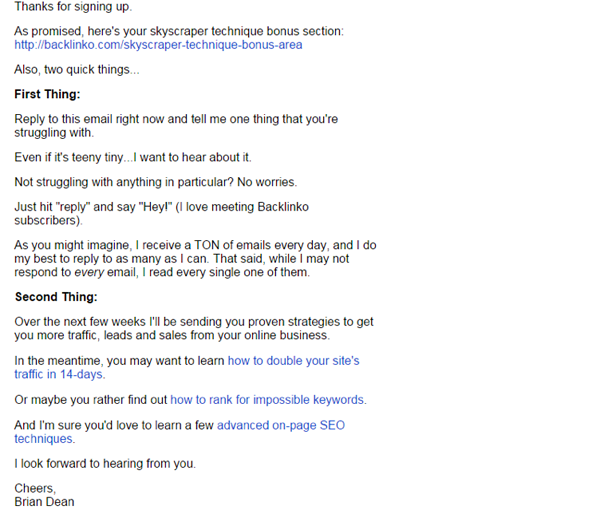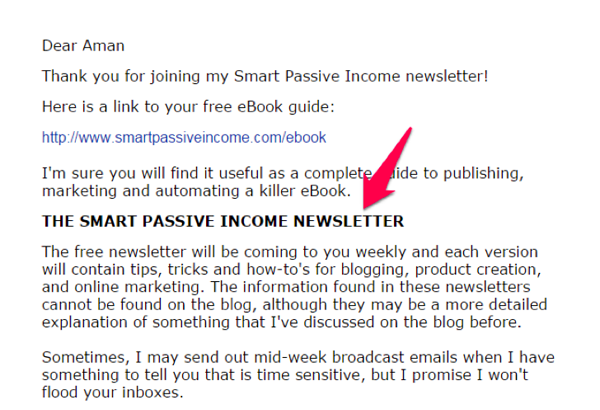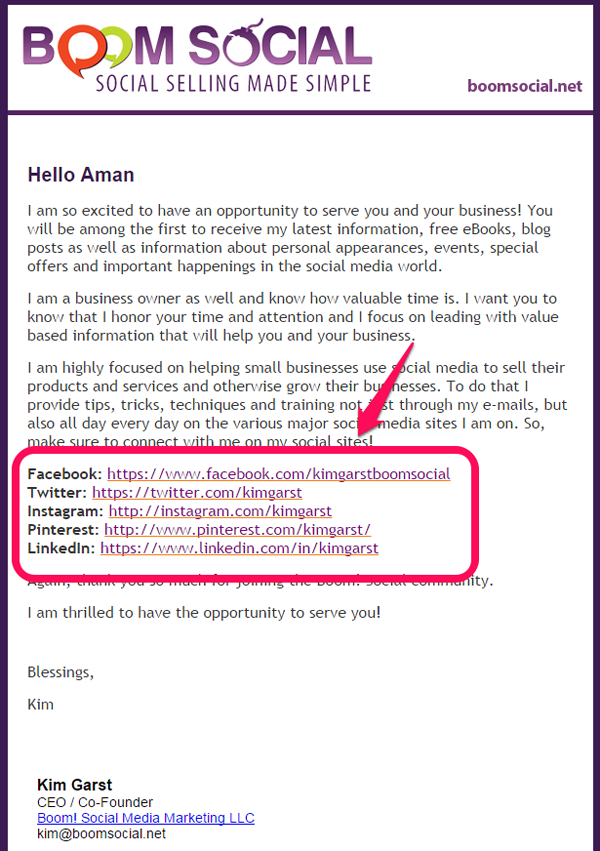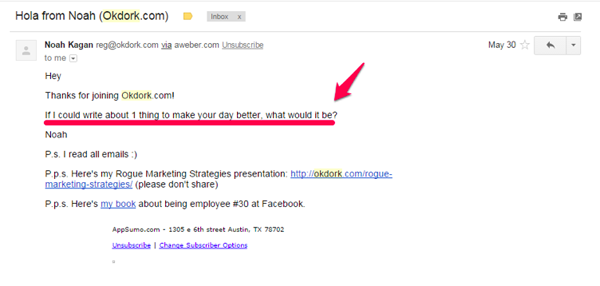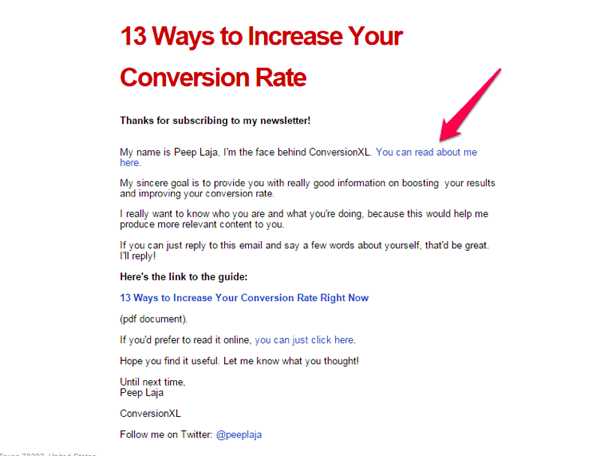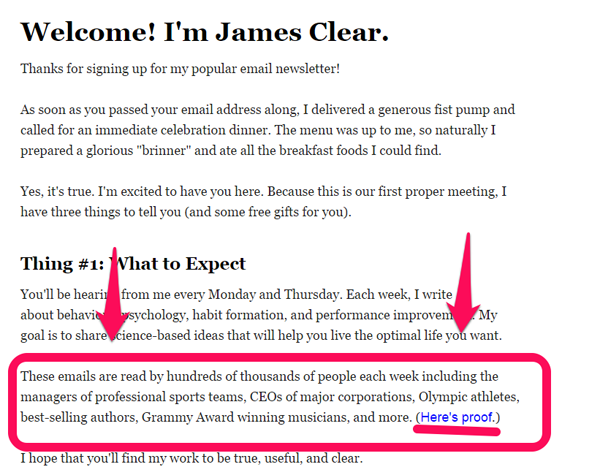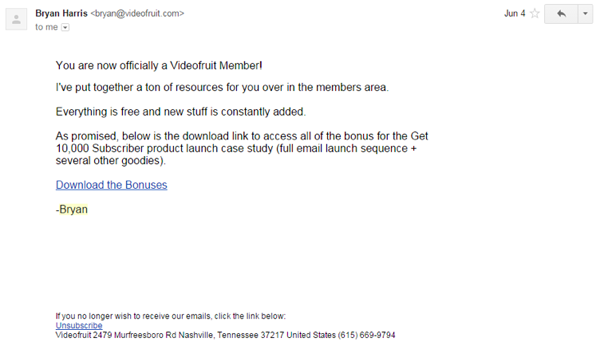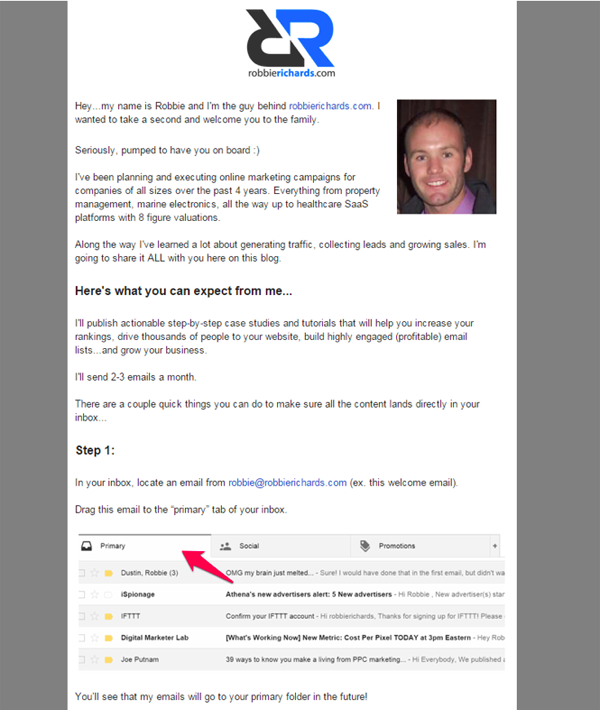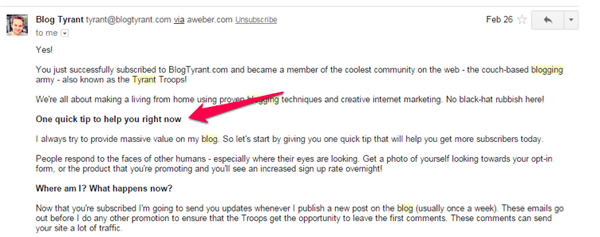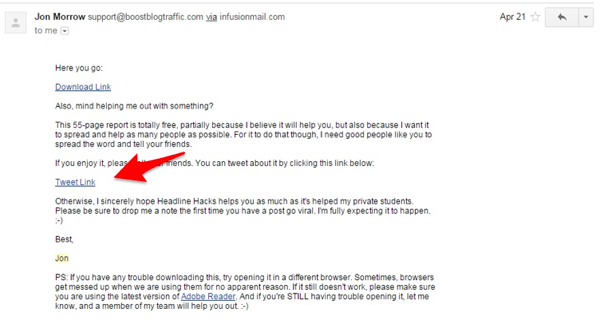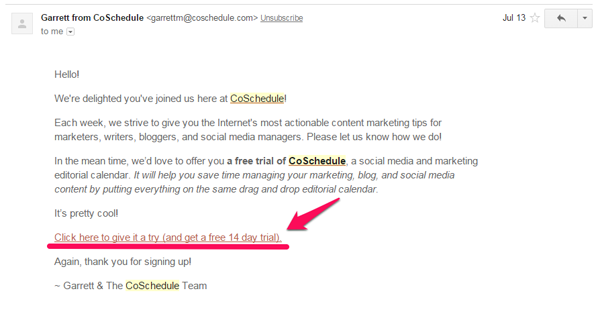Well, you finally did it.
You created an email list for your blog.
That means you’re now converting casual visitors into something far more valuable – subscribers.
Feels pretty good, doesn’t it?
It should. You started a blog, and you’re building a loyal audience who actively wants to hear from you. An audience you can reach at will, instead of hoping they’ll remember to return to your blog (because sadly, most won’t).
And if you’re smart, you’ll do everything you can to coax new people to join your shiny new list.
But while focusing on your list is healthy for your blog, it can also expose you to a dangerous pitfall:
You can become so single-minded about getting people to subscribe that you don’t think about what happens afterwards.
Big mistake.
Because those early interactions with new subscribers are crucial. They set the tone for your new relationship, and they happen in that precious “honeymoon” period where readers are actively thinking about your blog and the value it could provide to them.
And the start of that relationship rests on one simple communication:
Your welcome email.
So you’d better get it right.
The One-Time Opportunity You’d Be Totally Crazy to Squander
Your welcome email is the message that’s sent automatically to new subscribers after confirming they want to sign up for your list.
In its simplest form, it’s a short thank you message. And if you offer your subscribers a juicy sign-up incentive, it’ll tell them how to get that too.
In fact, that might be the reason that welcome emails have the highest open rate – up to 60% – of all types of marketing emails.
Given those numbers, you’re missing a huge opportunity if your welcome email says little more than “Thanks for subscribing!”
When your new subscribers open that first email, their interest levels are at an all-time high. It’s a rare situation in which you have your reader’s undivided attention.
So here are some quick but highly effective ideas to make sure you (and your subscribers) get every ounce of value from your welcome email.
1) Lead Subscribers Toward Your Greatest Content Hits
When subscribers join your list they have a mixture of emotions.
They hope they’re going to get a ton of value from being on your list, but they fear they’ll be disappointed.
That why you need to impress them as soon as possible after signing up.
One of the best ways is to use your welcome email to point them toward your most valuable content – the posts that have already proved to be popular with your audience.
Linking to popular posts will:
- Give new subscribers a “quick win” by helping them with a common problem
- Deepen the sense of connection between new subscribers and your content
- Generate traffic and create additional opportunities for social sharing
You can simply include a short list of your most popular posts in your welcome email, or use anchor text to lure subscribers, just like Brian Dean (founder of Backlinko) does in this welcome email:
2) Use Total Transparency to Build Their Trust and Respect
Bloggers are sometimes a little sneaky.
They’ll offer a juicy “bribe to subscribe” in exchange for your email address, but aren’t completely transparent about how it will be used.
In practice, of course, once you’re on their list, they’ll start sending you their latest content.
But even if they do state their intentions up front, readers are often too focused on getting the freebie to notice the small print.
Your welcome email is a great place to remind them exactly what they can expect from you – before you send them anything they might not be expecting.
This kind of transparency:
- Builds trust and respect
- Creates anticipation for what’s to come
- Reduces your unsubscribes
When setting readers’ expectations, be sure to cover the following items:
- How often they’ll hear from you
- What type of content they can expect to receive
- Any other promise, such as “I’ll never send you affiliate links”
Here’s a great example from Pat Flynn, founder of Smart Passive Income:
Notice how Pat tells his subscribers:
- They can expect to receive his newsletter on a weekly basis
- It’ll cover “tips, tricks and how-tos for blogging, product creation and online marketing”
- He may send the email during weekdays if it’s time-sensitive
As a result, within minutes of signing up to Pat’s newsletter you know exactly what to expect – so there’ll be no nasty surprises down the line.
3) Multiply Your Connections by Turning Subscribers into Followers
Savvy bloggers know that email subscribers are far more valuable than social media followers.
Some have even gone as far as removing their social profile links from their blogs because they distract readers from the main goal – signing up to the blogger’s list.
But that doesn’t mean that a strong social following is worthless. Far from it. The more connections you have to your audience, the stronger the relationship will be.
So once you’ve persuaded someone to join your list, it’s the perfect time to make sure they’re following you on social media, too.
Here’s how Kim Garst of Boom Social does it:
4) Get Valuable Intelligence about Your Readers’ Burning Questions
Take a look at this email from AppSumo and OKDork founder Noah Kagan:
Notice the second line where he asks, “If I could write about 1 thing to make your day better, what would it be?”
Not everyone will click reply, but a good number will. Just imagine what Noah could do with the answers. He could:
- Generate ideas for future blog posts
- Improve user experience by showcasing his most relevant content
- Create a new product that solves his readers’ most common problems
Noah’s email works so well because:
- It’s short and sweet – so it takes little effort to read
- His question is clear and direct – so it’s easy to answer
- He gives subscribers an incentive to hit reply (“I read all emails”)
As your list grows, this single question could you give you an almost inexhaustible supply of new ideas for your blog.
5) Showcase Your About Page
You’ll have heard it many times before: your About page is the second-most visited page on your blog after the home page.
That’s why you should invest time in crafting an About page that builds your credibility and likeability. (Neil Patel uses an eye-catching illustration and interesting personal details to ensure his page stands out from the masses.)
Once you have an About page to be proud of, it’d be a real waste if the only people who saw it were those who stumbled across it, right?
So why not use your welcome email to send new subscribers to your About page? It helps put a face to the blogger behind the blog and it’s a clever way to reuse content you’ve already invested your time in.
Here’s a great example from Peep Laja of conversionXL:
6) Use Social Proof to Convince Cautious Subscribers
Imagine you’re buying a new gadget on Amazon.com.
And let’s say it’s a toss-up between an established product with dozens of five-star ratings and a brand-new product with no ratings at all.
Which one feels like the safer purchase?
The first one, right? Even though the second product might still be excellent, there’s no evidence that it is.
Most people like making choices that have already proven popular with other people – we find safety in numbers. It makes our decisions feel less risky.
Author Robert Cialdini calls this social proof, and your welcome email can effectively exploit this human tendency.
Use evidence from other people to reassure your new subscribers that they’ve made a smart choice by signing up.
James Clear does it by telling us how many people already read his emails and the types of smart people that list includes:
While few people can make the same impressive claims as James, even simple elements of proof, like a quote or two from existing readers, can be seriously persuasive.
7) Delight Them with an Unexpected Bonus
Nowadays people almost take it for granted that bloggers will offer an incentive to new subscribers.
Exclusive audio recordings, free ebooks and handy checklists – these are just a few of the freebies you can use to lure new subscribers.
But because such “bribes” are so commonplace, even a genuinely valuable giveaway can feel underwhelming.
That’s why you should try to over-deliver. So give your new subscribers something extra – more than you originally promised.
It’s a great way to build trust early in the relationship and to overcome any skepticism that tells them the only reason you’re giving something away is to get their email. (It’ll also make them wonder what bonuses you might give away in future.)
So why not create an area on your blog with free resources exclusive to your subscribers and tell them about it in your welcome email?
Bryan Harris (founder of Videofruit) gives subscribers immediate access to his members’ area as soon as they subscribe to his mailing list:
8) Protect Your Emails from Getting Sidelined or Junked
Sending emails to your subscribers is pointless if they don’t get seen.
One of the biggest frustrations for email list owners is having content marked as spam by overly aggressive filters. Subscribers get frustrated too, because it means they miss the updates they chose to receive. (The best antidote is to have clear instructions on the “Thanks for subscribing” page on your blog explaining how to whitelist your email address.)
But a newer threat appeared a couple of years ago when Gmail – the most widely used email service – introduced the Promotions tab and started funneling anything that looked like a marketing email into it.
The problem is that most Gmail users open the Promotions tab far less frequently than the Primary tab – where non-marketing emails such as those from friends appear. The result – your open rates plummet.
That’s why Robbie Richards, founder of RobbieRichards.com, uses his welcome email to tell people to move his email from the Promotions tab to the Primary tab. Once his subscribers do that, all future emails will land straight into the Primary tab, where they have the best chance of being opened and read.
9) Give Your Subscribers an Unexpected Quick Win
Know the best way to make sure people are glad they joined your list?
Give them a quick tip that gets them some results right away. Before they even receive any regular content from you.
Even a teeny tiny tip that teaches them something valuable right now can have a powerful effect.
Try to pick something that most subscribers won’t know but will work for almost everyone.
And remember, it doesn’t need to deliver huge results, just quick results.
Ramsay Taplin, founder of Blog Tyrant, has a great example of this tactic in his welcome email:
This email is effective because:
- It’s a useful tip that will get results
- He explains why it works
- It’s super-actionable, meaning you can apply it right away
10) Persuade Subscribers to Promote Your List – For Free!
Growing your social media following is useful, but it’s not the only reason to leverage social media in your welcome email.
When Smart Blogger visitors sign up to receive Jon Morrow’s famous “Headline Hacks” report, the welcome email immediately asks them for a quick favor – to tweet a link to the sign-up page so their followers can get the same report (and, of course, join Jon’s list):
If it seems cheeky to ask for a favor so soon after sign up, remember that many people will want to reciprocate the favor Jon just did them – sending them his valuable report.
And note how the favor itself is very carefully worded. Sharing the link is positioned as a way to help other people – not just helping Jon build his list.
11) Make Subscribers an Offer They Can’t Refuse
For some people, earning money from blogging is the ultimate goal.
So if you have have a product or service that’s suitable for new subscribers, don’t be afraid to make a gentle pitch in your welcome email.
If you’re worried that people will unsubscribe from your list if you try to sell them something too soon, you needn’t be.
As long as the pitch is friendly with no pressure to buy – and it doesn’t seem like making a sale is the main purpose of the email – you’ll be just fine.
Try to make the offer as attractive as possible by using powerful words and giving an exclusive subscriber discount, or a free trial as CoSchedule do here:
Making an offer early in the relationship not only gives you the opportunity to land a few extra sales and make money, but it lets readers know that you have something to sell. Which means they won’t get a nasty surprise when you make a more determined pitch later down the line.
Let’s Make Your Welcome Email Work Harder and Smarter
Connecting an email list to your blog is like flicking a turbo switch – everything accelerates.
But however fast your list is growing, if you don’t optimize your welcome email, you’re leaving money on the table (even if you’re not monetizing your blog).
A strategic welcome email gets bigger and better results from fewer subscribers. It’s a quick and easy change that keeps giving back because every new subscriber receives the email.
So if you’re excited about “leveling up” your welcome email (and you should be!), pick one of these approaches and implement it right away.
You could even combine two or three tactics in a single email as some of the bloggers above do.
Just remember, you don’t get a second chance to send your first email to new subscribers.
So make it count.
About the Author: Aman Thakur is a digital marketer with an analytical approach to list building and email marketing. Go ahead and get started building your email list through his blog, Email Field.
The post Why You’re Wasting Your Welcome Email (and What to Do About It) appeared first on Smart Blogger.
